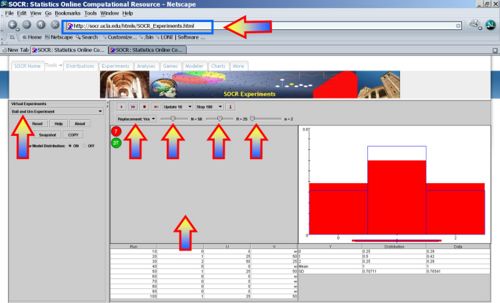SOCR Events May2008 C3 S1
From Socr
SOCR May 2008 Event - Calculate probabilities of events and compare theoretical and experimental probability
Solve counting problems using the Fundamental Counting Principle
Calculate the probability of an event or sequence of events with and without replacement using models
The Ball and Urn Experiment demonstrates the effects of sampling with or without replacement. Suppose we choose n balls at random from an urn containing R are red and (N-R) are green balls. For every trial, the number of red balls drawn (Y) are recorded numerically in the distribution table (on the right) and graphically in the distribution graph (blue). At each trial, the empirical frequency of Y is displayed in red the distribution graph. The experimenter has the abilities to manipulate trials by choosing with replacement or without replacement in the list box and varying parameters N, R, and n with scroll bars.

- Why is there a difference in sampling balls from the urn with or without replacement?
- Set N=50, R=25 and n=2. If you sample with replacement, what is the chance that we get 2 red balls in the sample of 2?
- If we sample without replacement and the first ball is red, what is the chance that the second ball will be also red? Is this probability effected by knowing the collor of the first drawn ball?
- If we increase or decrease R (number of red balls in the urn), how is the probability of drawing a red ball changing? Notice how the distribution (blue graph) becomes left- or right-skewed.
Recognize that the sum of the probability of an event and the probability of its complement is equal to one
Make approximate predictions using theoretical probability and proportions
Collect and interpret data to show that as the number of trials increases, experimental probability approaches the theoretical probability
Compare two similar sets of data on the same graph
Compare two different kinds of graphs representing the same set of data
- Compare the Line Plots and the Scatter Plots for the Human heights and weights dataset.
Propose and justify inferences and predictions based on data
Refer to the Line Plots and the Scatter Plots for the Human heights and weights dataset.
- Is it likely that someone is 80 inches tall if his/her weight is only 100 pounds?
- What is a reasonable height in inches for someone who is 130 pounds in weight (notice that this is the mean weight of an individual, so we may expect the mean height (68.4 in) to be a reasonable estimate)?
References
- Utah Secondary Core Curriculum Standards for Statistics
- Interactive Statistics Education EBook
- SOCR Home page: http://www.socr.ucla.edu
Translate this page:
